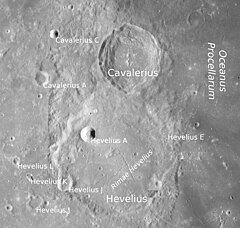Heweliusz (krater księżycowy)
 Kratery Heweliusz i Cavalerius (mniejszy powyżej) oraz ich kratery satelickie. Po prawej stronie równina Planitia Descensus (zdj. NASA). | |
| Ciało niebieskie | |
|---|---|
| Średnica krateru | 113,87 km |
| Źródło nazwy | |
Heweliusz (Hevelius) – krater na powierzchni Księżyca o średnicy około 114 km, położony na współrzędnych selenograficznych ☾ 2,20°N 67,46°W/2,200000 -67,460000[1].
Decyzją Międzynarodowej Unii Astronomicznej w 1935 roku został nazwany nazwiskiem polskiego astronoma Jana Heweliusza[1].
Satelickie kratery[1]
| Heweliusz | Szerokość | Długość | Średnica |
|---|---|---|---|
| A | 2,85° N | 68,23° W | 14,01 km |
| B | 1,36° N | 68,98° W | 13,5 km |
| D | 3,05° N | 60,91° W | 7,76 km |
| E | 2,96° N | 65,78° W | 8,81 km |
| J | 0,8° N | 69,9° W | 13,13 km |
| K | 1,58° N | 70,08° W | 5,67 km |
| L | 2,04° N | 70,48° W | 7,6 km |
Zobacz też
Przypisy
Linki zewnętrzne
Media użyte na tej stronie
Autor:
- Nuvola_apps_kmoon.png: David Vignoni / derivative work: Lady Whistler (talk)
Icon from Nuvola icon theme for KDE 3.x.
cylindrical map projection of the Moon. The Moon's whole surface was mapped by the Clementine spacecraft in 1994, here North is at the top. The dark floor of crater Plato is at the middle top above Mare Imbrium, while the bright floor and rays of crater Tycho is near the middle bottom below Mare Imbrium. Mare Procellarum is at the near left, and Mare Tranquillitatis is just right of centre and Mare Crisium is at the near right. The far left and far right show the contrast of the mostly cratered farside with small isolated mare.
Shiny LightSteelBlue button/marker widget. Used to mark the location of something such as a tourist attraction.
Craters Cavalerius and Hevelius (detail of LRO - WAC global moon mosaic; Mercator projection)




